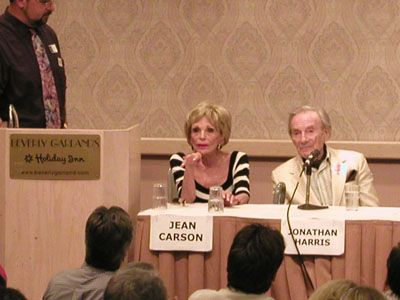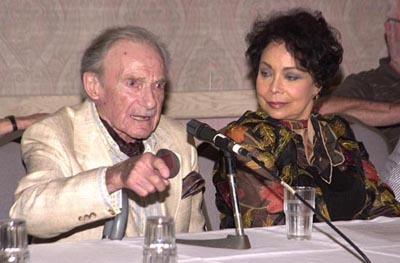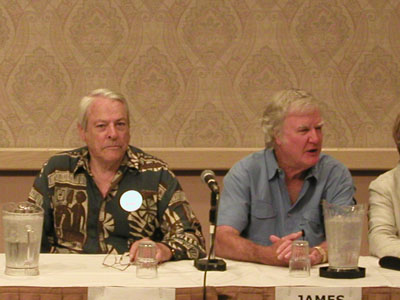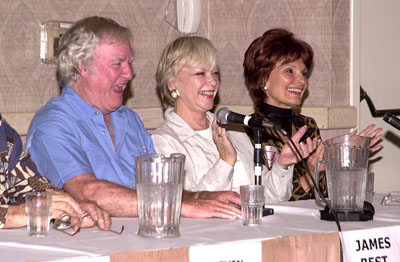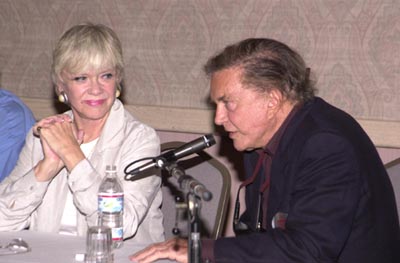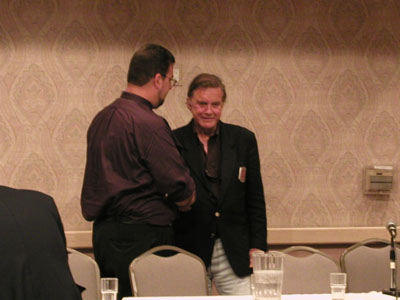Actor Panel

Notes: These are in order of speaker and just briefly summarize each person's comments. The duration of this
panel discussion was roughly 60 minutes. Some details may be outdated.
Tony Albarella (host): Tony introduced himself as
member of the Rod Serling Memorial Foundation and mentioned his upcoming book with Earl Hamner. He mentioned the few articles
he's written on "Twilight Zone" and Serling, to which Jonathan Harris interrupted him with the following humorous quip,
"Are you paying for this? (No!)
Then why am I here? I learned this old addage many, many years ago: 'Don't give it away, SELL IT!' Worked well for me! Haha!" Tony didn't need to do much more than introduce each panelist...they pretty much took it from there!!
Cliff Robertson, "The Dummy" and "A Hundred Yards Over the Rim": Cliff was flying one of his planes on September 11, 2001.
He passed over the World Trade Center
and saw a column of smoke yet there wasn't a cloud in the sky. He was radioed by the air traffic control and the operator on the other
end told him that we were in a national emergency. He was ordered to land in Allentown, Pennsylvania and spent three uneventful
days there! Shortly before the filming of "The Dummy", Cliff was sent a copy of the shooting schedule. He lived (and still lives) in New York
and did not want to come out to California any sooner than he had to. The production staff wanted him to come out
to the studio about five days before he would actually start rehearsing and shooting his scenes, and they'd already
booked his flight. He called a friend and asked for advice about not arriving early. The friend
said, "Cliff, you're crazy!" Ultimately, because the contract didn't make any specific mention of dates that Cliff
had to be there prior to shooting his own scenes, he cancelled the flight. The plane took
off early that Friday morning on schedule. An hour or so into the flight,
the pilot had a heart attack and the plane went down. There were no survivors.
"A Hundred Yards Over the Rim" was a fun shoot for Cliff (except for having to be stuck in the black tux and tails
in the blazing desert heat out in Lone Pine!), and the stovepipe hat was indeed his idea.
While today it succeeds in making the episode a gem, one or two of the network brass saw it
in the dailies and objected. Rod Serling heard about it too, but thought it was a fantastic idea;
the stovepipe hat stayed!
Jean Carson, "A Most Unusual Camera" : Rod Serling came backstage after a play Jean was doing in LA around 1959. He'd seen her in
one or two of the plays she'd done in New York before coming out to the west coast.
He said he had an idea for a story, "A Most Unusual Camera", that he thought would be great for her.
However, the episode was not produced right away. Rod wrote the script, but CBS Continuity
objected to the ending of the episode. He rewrote the ending several times
before they finally accepted the episode as a whole and ok'd production. Meanwhile,
Rod kept in touch with Jean by phone over a period of more than a year. The shoot
was very fun for Jean and the character Paula was right up her alley. The ending,
she felt, with all of them dumping out of the window, was a little on the arbitrary side...but the reason CBS was not willing
to accept Rod's endings was because they felt the crooks (Chester, Paula,
Woodward, and The Waiter) were not being punished enough for their misdemeanors. She reports
that she did not have a good experience with the director of the episode, however! Still,
"A Most Unusual Camera" remains one of a group of televisional episodes that Jean is well-remembered for.
Jonathan Harris, "The Silence" and "Twenty Two" : Jonathan wove a colorful story
about Irwin Allen, creator/executive producer of "Lost in Space", a genius who unfortunately had no sense of humor and
a nasty temper. Irwin would scream at
directors and cause a raucous on the set. Jonathan would
always flee to his dressing room and wait until he was told it was safe to come out!
He talked of his friendship with Rod Serling and how he used to talk about the difficulty of TV networks. Rod used to say, "They don't
know what I'm doing … someday, they're going to kill me." And they did!
He remarked about how stupid the networks are, and always have been.
On "Lost In Space", he was supposed to play (in his words) a "deep, dark villain", which
very few actors can do well … Jonathan envisioned a comedic villain and gradually changed his approach
to the character of Dr. Smith. The result was that "Lost In Space" stayed on the air for 85 episodes.
He also talked a bit about a "Lost in Space" Reunion movie in which the character
of Dr. Smith had been written out.
So, he rewrote the whole thing himself and as of right now, the project is "not a green, but a yellow". Jonathan cracked up everyone in the audience with his humorous comments and recitation of
some of his self-coined phrases from "Lost In Space" including "Bubbleheaded Booby", "Neanderthal Ninny" and "Perspicacious Pipsqueak" (references to the robot, who was Dr. Smith's straight-man).
He is a world-class raconteur.
Arlene Martel (formerly Arline Sax), "What You Need" and "Twenty Two" : Arlene talked a bit about her
training in the New York Actors Studio and working with Sidney Lumet. During production of the
episode, she wrote a five-page description of the character she played on "What You Need", a small role as a girl in the bar, which was one of her first TV roles.
This was a difficult task, as she only had five or six lines total and most of the
time she sat in the booth smoking (a habit she gave up long ago!) Arlene was thrilled when they asked her
back to do "Twenty Two" a year or so later, and the experience affected her
deeply. After the shooting of that episode, the
sound of Barbara Nicholls' screaming after hearing her classic
line, "Room for one more, honey..." gave her nightmares for about six months.
Jonathan Harris (who played the doctor) certainly remembered Arlene and her famous line, even though
it had been 42 years since they'd last seen each other.
Arlene remarked that our Show was the best she'd ever attended, due in
large part to one fan-collector who had unearthed two letters she'd
written to James Dean many, many years ago. She continues to
be active in the biz, and recently completed shooting of a film called "Heartbreak Cafe".
She has written a film called "Whisper into My Good Ear",
in which Martin Landau will appear.
Wright King, "Shadow Play" and "Of Late I Think of Cliffordville" : Wright
remembered Cliff Robertson's generosity back in the late 1940's when he
and his wife June were getting married and going on their honeymoon.
Wright had planned to take her to a not-very-nice hotel in New York,
but Cliff suggested they use one of his apartments instead! Wright had
worked with nearly every actor on the panel and was flooded with
tons of memories.
William Windom, "Five Characters in Search of an Exit" and "Miniature" : The distinguished Mr. Windom came in and sat down, but quickly got up again saying that he wasn't going to make any money on photo sales by
sitting there on the panel. However, not being one to cheat his audience, he cracked the following joke
before exiting out the back door of the theater: "What did one flamingo say to the other? Egrets, I've had a few."
Kevin McCarthy, "Long Live Walter Jameson" : Kevin remembered
well his experience filming "Long Live Walter Jameson". "In that episode," he
recalled, "I played a man who just lived and lived and lived...and I am
still playing that character." The makeup job by William Tuttle, for him, remains the most
memorable experience of the shoot, as well as working with
Estelle Winwood (who was a great friend of Tallulah Bankhead in those days,
and in fact, the much older Estelle outlived Tallulah by nearly 20 years).
The makeup supposedly cost MGM $25,000 and it was an exhausting
process, but it was sure worth it! Anne Francis piped in and recalled
a segment from her show "Honey West" where she had wrestled with
Kevin!!
James Best, "Jess Belle", "The Last Rites of Jeff Myrtlebank", "The Grave" : "Jimmie" told the audience how deeply moved he was that he was cast opposite
the gorgeous Anne Francis in "Jess Belle". In those days he was playing
a lot of roughnecks in westerns and in "Dukes of Hazzard" he got stuck with a hog and a dog (!!),
but "Jess Belle" was different and very much suited his abilities as
an actor. He recalled, "She [Anne Francis] turned into a panther at midnight!", to which
Anne replied, "Still do!!" The trainer who was working with the panther had
a difficult time working with the cat, which was placed on the roof of a prop log cabin. He was also
not tied down or on any kind of leash. When he came out onto the porch
to light his pipe in the scene, filming ceased momentarily when the
trainer said in a low voice, "DON'T MOVE." The animal was getting impatient from
having been on the roof too long and was liable to jump down at any moment. The scene was eventually
completed, but not without a great deal of fear! Jimmie also mentioned that he never
got to meet Rod Serling. Later on, when an audience member asked him if being cast as roughnecks
in any way was detrimental to his career, he replied, "No, but I'd like to go to my grave
with people remembering me as a fairly good actor and not just Roscoe Coltrane and the 'Kee kee kee!' thing!"
Anne Francis, "The After Hours" and "Jess Belle" :
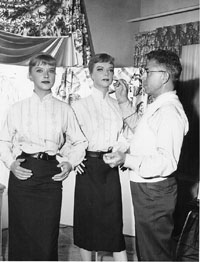 Anne had a similar experience with a lion she was posing for a publicity shot with, who nearly bit her head off,
literally! Luckily the trainer was good and got the lion to let go! She recalled how "Jess Belle" and "The After Hours" were shot with three cameras. "The After Hours"
was a week-long (five day) shoot with virtually no rehearsal. Rod Serling
was close by during the shoot and he and Anne became friends. She remarked
that Rod was a genuinely nice person who really and truly cared about every
facet of the production, including the actors. Anne remarked that Elizabeth "Liz" Allen was great to work with and did a fine job with her part as the saleslady (who sells
Marsha White the gold thimble). James Milhollin
as the store manager who does the famous double-take at the very end was also great to
work with.
One person from the audience made mention of the remarkable final
scene and Marsha White's resignation...that
she's in fact a mannequin, was so greatly executed and was so believable. Anne
agreed, remarking how it was difficult, yet rewarding in the end, to have
Marsha White build up to such a massive hysteria. Anne was asked about the
Marsha White mannequin. She still has the head, constructed
by makeup artist Charlie Schramm, which today she uses to put her straw hats on. In between their individual
discussions, Anne and James Best
held their own conversation for the audience about several films they'd done
together, including "The Rack" and "Forbidden Planet" (which Jimmie had
completely forgotten about 'Because I was killed off so quickly in that one!')
Anne had a similar experience with a lion she was posing for a publicity shot with, who nearly bit her head off,
literally! Luckily the trainer was good and got the lion to let go! She recalled how "Jess Belle" and "The After Hours" were shot with three cameras. "The After Hours"
was a week-long (five day) shoot with virtually no rehearsal. Rod Serling
was close by during the shoot and he and Anne became friends. She remarked
that Rod was a genuinely nice person who really and truly cared about every
facet of the production, including the actors. Anne remarked that Elizabeth "Liz" Allen was great to work with and did a fine job with her part as the saleslady (who sells
Marsha White the gold thimble). James Milhollin
as the store manager who does the famous double-take at the very end was also great to
work with.
One person from the audience made mention of the remarkable final
scene and Marsha White's resignation...that
she's in fact a mannequin, was so greatly executed and was so believable. Anne
agreed, remarking how it was difficult, yet rewarding in the end, to have
Marsha White build up to such a massive hysteria. Anne was asked about the
Marsha White mannequin. She still has the head, constructed
by makeup artist Charlie Schramm, which today she uses to put her straw hats on. In between their individual
discussions, Anne and James Best
held their own conversation for the audience about several films they'd done
together, including "The Rack" and "Forbidden Planet" (which Jimmie had
completely forgotten about 'Because I was killed off so quickly in that one!')
Suzanne Lloyd, "Perchance to Dream" : When Suzanne got called by her
agent telling her that "Twilight Zone" wanted her, she jumped on it immediately.
She recalled, "Twilight Zone" was 'one of the shows to get' because
the quality of the show and the production values were so very high." She remarked how today she very
much missed Richard Conte and John Larch (this comment brought considerable applause from
the audience) who were both so incredibly accomplished and such a dream
to work with. In "Perchance to Dream", George Clemens (the photography director),
had the camera cockeyed throughout. Of course, this was atypical and
something Suzanne was not used to. There was not much levity on
that set, as the story was centered around a man having a heart attack
and a woman trying to kill him. A year or so later, Suzanne was asked
by the local circus if she wanted to do the 'Maya' routine in
a cage with a lion, and get back into the Maya costume again (this costume
was originally made for dancer Cyd Charisse). She jumped at this opportunity
too, being an animal lover! Unfortunately, like Anne Francis and James Best,
her experience with the cat met with disaster and she ended up going home.
Suzanne thanked everyone for coming, saying that they'd succeeded
in dissolving the impression that her work in TV and film had long been forgotten!
